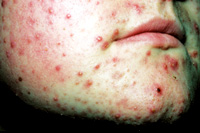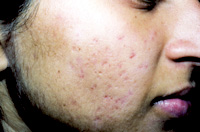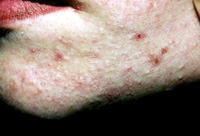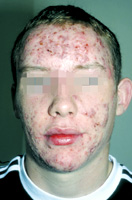
|
January 2003, Volume 25, No. 1
|
Update Articles
|
|||||||||||||
The treatment of acneA Drummond, F A Campbell, D T Roberts HK Pract 2003;25:17-21 Summary Acne vulgaris is a common skin disease mainly affecting teenagers and young adults. Most cases respond well to early intervention and can be easily managed in the community. Treatment comprises topical therapy for mild to moderate disease and oral agents for more severe involvement. Oral retinoids are usually reserved for cases that have been unresponsive to these measures. Patients benefit from a holistic approach to the management of their disease, which can be physically scarring and psychologically crippling. 摘要 尋常痤瘡是一種主要影響青少年和青年的常見皮膚病。如果早期治療,絕大多數病人反應良好, 無須到皮膚專科求診。輕度至中度病例多採用局部治療,重度病人可使用口服藥物。 上述治療無效者可服用維生素A。痤瘡不僅為病人帶來身體的疤痕,而且造成心理上的傷害, 所以醫生要提供治療身心健康的全人的服務。 Introduction
Acne is a chronic inflammatory condition usually presenting in adolescence and resolving by the mid-twenties. 90% of adolescents are affected and 30% will continue to have problems in adult life.1 Acne is a disease of the pilo-sebaceous units which are found all over the body with the exception of the palms and soles but their density is greatest on the face, upper back and chest. They are present at birth, when they are active as a reaction to maternal hormones. They atrophy in childhood prior to being re-awakened under the androgen influence of puberty. The characteristic lesions of acne are comedones, papules, pustules and nodules (Figure 1). Following the acute stage of acne, there may be residual scarring which will vary according to the site affected and severity of disease. On the trunk, scars may be hypertrophic (Figure 2) due to increased collagen whereas on the face they are more likely to have an "ice-pick" appearance (Figure 3). In pigmented skins chronic post-inflammatory pigmentation often results, which may be more upsetting than the original disease. The majority of acne patients can be very successfully managed by the family physician and specialist involvement should only be required for the more severe and recalcitrant cases. Pathogenesis of acne Four major factors are involved in the pathogenesis of acne:
Clinical presentation Acne predominantly affects the face, chest and the back. In younger patients open and closed comedones prevail and may be the first sign of puberty. As the disease progresses, more inflammation occurs and this can lead to superficial pustules or deep nodules. Nodules more commonly affect males and are often associated with pain and disfigurement. They may be localised or extensive and can be linked by sinuses that become inflamed and scarred. In its most severe form, nodular acne is chronic and widespread, associated with multiple sinuses, numerous comedones and severe scarring. This rare variant, known as acne conglobata should be managed by a dermatologist, as should acne fulminans which has systemic features such as fever and arthropathy. Management The mainstay of any acne therapy is patient education and an understanding of the individual's needs. Treatment should embrace the psychological and the physical aspects of the disease and patients should be reassured that their problem is commonly encountered, usually very responsive to therapy and unrelated to cleanliness, diet or lifestyle. Early therapeutic intervention is recommended to minimise the potential for scarring but patients should be advised that there can be no "quick fix" and that any treatment may take at least eight weeks to effect any obvious improvement. Affected areas should be washed twice daily with gentle soap and water and female patients should use oil-free non-comedogenic cosmetics. Acne lesions should not be tampered with as this can result in further inflammation and scarring. Topical treatments are adequate in many cases of mild to moderate acne, the choice of preparation being dictated not only by the clinical appearance but also by the patient's tolerance. Creams are useful for dry or sensitive skins. More oily skins will benefit from the drying effect of gels but these can cause irritation. Gels also act as a poor base for the application of cosmetics. Lotions are easy to spread but may also irritate and solutions of topical antibiotics are frequently alcohol-based and prone to cause discomfort. Many patients will have tried over-the-counter preparations such as antiseptic washes, abrasive facial scrubs or salicylic acid-based comedolytics. Sulphur preparations have largely fallen into disrepute because of their unpleasant odour. Topical treatments The selection of suitable topical treatment is dictated by the clinical findings and patients should be instructed to apply the agents to the acne-prone areas as well as to the lesions themselves. This targets the subclinical micro-comedones that are known to exist in areas surrounding the affected skin.3 Benzoyl peroxide This is an oxidising agent that introduces oxygen into the hair follicle. Since P.acnes is anaerobic this creates a hostile environment for the bacterium and has a bactericidal effect. Consequently bacterial resistance is not a problem. Apart from this anti-bacterial action, it also has anti-inflammatory and anti-comedonal properties. Concentrations vary from 2.5-10% but there is little evidence that the efficacy is dependent on the dose.4 The compound is available as a cream, a lotion and either an alcohol or a water-based gel. Local irritation can be a problem and low strengths should be used initially to minimise this problem. The patient should also be warned of the bleaching effect on clothing, bed linen and towels. Topical retinoids These are vitamin A derivatives that slow down desquamation thereby decreasing the number of comedones and micro-comedones. These drugs also have anti-inflammatory activity and are useful for mild to moderate disease or as maintenance therapy following oral treatment. Tretinoin and its isomer isotretinoin are prone to cause erythema and scaling which is enhanced by facial scrubs, antiseptic cleansers and exposure to UV light. Adapalene is a synthetic retinoid available as a gel or cream and considered less irritating than other topical retinoids. These agents can be used safely in conjunction with other topical therapies without inducing bacterial resistance. They should be avoided in pregnancy and severely excoriated skin. Azelaic acid This has anti-comedonal and anti-bacterial properties but does not produce P.acnes resistance. It is therefore a useful alternative to topical retinoids for easily irritated facial skin. It can decrease skin pigmentation which may be useful in postinflammatory hyperpigmentation but should be used cautiously in patients with darker complexions. Topical antibiotics Clindamycin and erythromycin are the most commonly used topical antibiotics and work directly by killing P. acnes. A major concern is increasing bacterial resistance which may be compounded by simultaneous use of a different oral antibiotic and such combination therapy should be avoided. In mild to moderate cases they are no more effective than topical benzoyl peroxide or retinoids and their use should be reserved for patients who cannot tolerate oral antibiotics. They sometimes cause local irritation and skin sensitisation can occasionally be a problem. Combination therapy If the patient has both comedones and inflammatory lesions more than one topical treatment may be used in a combined fashion. However, there are now several proprietary mixtures on the market. These are available as the following:
Results for products such as benzoyl peroxide with erythromycin have been shown to be better than with either component alone5 and this may be due to decreased bacterial resistance in the presence of benzoyl peroxide. Physical treatments
Simple blackheads can be gently expressed using a comedone extractor or clean fingers. Large whiteheads (macrocomedones) (Figure 4) can be a cosmetic problem and may develop into inflamed and potentially scarring lesions, especially in patients on oral retinoids. They are best treated with mild cautery following the application of local anaesthetic cream. Acne nodules may be very painful and some patients benefit from the application of topical steroids during the development of such lesions. Larger lesions may be aspirated then injected with intralesional triamcinolone. When acne is completely burned out but residual scarring remains, plastic surgery in the form of chemical peels or laser re-surfacing may be considered. However, the prevention of scarring by early therapeutic intervention remains an important goal in the treatment of acne. Systemic treatments
Antibiotics Antibiotics are the most widely prescribed therapy for acne vulgaris,7 especially in the primary care setting. Proprionibacteria, especially Propionibacterium acnes and P. granulosum are implicated in acne pathogenesis, although their exact role is still poorly understood. It is assumed that antibiotics work primarily as antibacterial agents but an anti-inflammatory action is another possibility. The most commonly prescribed oral antibiotics are tetracyclines (tetracycline, oxytetracycline, doxycycline, lymecycline, minocycline (100-200mg per day)), erythromycin and clindamycin. Trimethoprim 300mg twice daily is useful in cases unresponsive to the other antibiotics8 and in cases of gram negative folliculitis. Prolonged use may depress haematopoiesis and should not be continued for more than 2 months unless under supervision of a dermatologist. Antimicrobial therapy usually lasts a minimum of six months, and can continue for years. There should be signs of improvement by 3 months but if this is not the case an alternative antibiotic should be tried. Therapy should be continued until the acne has resolved and protracted courses will be required if the patients' acne continues into later adult life. Such long exposure to antibiotics leads to resistance in the pathogenic organisms and consequently treatment failure. Studies have shown that skin colonisation with antibiotic-resistant propionibacteria is now much more common than a decade ago, with a prevalence of 55% in the year 2000.9 Resistance to erythromycin is more common than to tetracyclines, which has risen little over the last 10 years.9 Minocycline offers the least likelihood of bacterial resistance but publicity over rare adverse effects has resulted in reduced prescribing of this drug in many countries. It is important to combine systemic antibiotics with topical preparations in the treatment of acne as most therapies only act against one or two of the aetiological factors. The use of topical retinoids, azelaic acid and benzoyl peroxide may be helpful to try and prevent P. acnes resistance.9 Hormones Various regimens exist and are usually initiated if antibiotic therapy has failed or if concomitant menstrual control or contraception is required. Antiandrogens are the most common hormonal therapy but low dose prednisolone plus oestrogen and spironolactone may be used on rare occasions. Topical therapies are usually recommended alongside hormonal treatments. Antiandrogens suppress sebum production and are only available as oral preparations. Cyproterone acetate (CPA) 2mg combined with ethinyl oestradiol 35mcg (Diane-35) is an oral contraceptive pill that improves acne. It reduces sebum production by 20% but giving 50mg or 100mg CPA from the 5th to the 14th day of the cycle can further increase this reduction.6 Diane-35 is slow to act and may take up to 6 - 12 months to effect improvement. Spironolactone 200mg daily reduces sebum production by 70% and can be used in females over the age of 30 years6. A question remains over its long-term safety and is therefore best prescribed by a dermatologist with experience of this treatment in acne. Low dose prednisolone (2.5mg on waking and 5mg at bedtime), with or without the addition of the contraceptive pill, will reduce sebum production by up to 50% resulting in an improvement in acne.6 Again this treatment is rarely used and should be prescribed by a dermatologist. Oral prednisolone may also be required in larger doses for severe cystic or inflammatory acne and acne fulminans. Management of these patients is best co-ordinated by a dermatologist. Isotretinoin
Oral isotretinoin (13-cis-retinoic acid; Roaccutane in the UK; Accutane in the USA) is the most clinically effective drug for the treatment of acne. It dramatically reduces sebum production, reduces comedone formation, reduces the P. acnes population and is anti-inflammatory.10 It is the only anti-acne agent that has activity against all four aetiological factors. It was initially used to treat very severe cystic acne (Figure 5) but in recent years is being prescribed for less severe disease that has failed to respond adequately to oral antibiotics. Patients with mild acne resulting in significant psychological distress are also being treated with isotretinoin. There is variation worldwide in the dosing regimens used with the UK using 0.5-1mg/kg/day and the USA using 1-2mg/kg/day.10 The dose is usually adjusted according to clinical response and side effects with a conventional course lasting 16 weeks. There is some evidence to suggest that a dose of at least 1mg/kg/day will induce a more permanent remission.11 The vast majority of patients respond well and are clear at the end of their treatment course. Isotretinoin is teratogenic and should not be prescribed to females of childbearing age if there is any possibility of pregnancy. In the UK a negative pregnancy test is required prior to commencing treatment whilst, in the USA an additional negative test is required at the end of each month of treatment. It is recommended that two forms of contraception be used if the patient is sexually active and this should continue for four weeks after cessation of the drug. Teratogenicity should be fully discussed with the patient and they must sign a consent form to indicate that they understand these issues. Side effects are relatively common from isotretinoin and include chelitis, nasal dryness, blepharo-conjunctivitis, dermatitis, arthralgia, myalgia and headaches. An increase in serum lipids and derangement of liver enzymes may also be seen. Uncommon but important side effects include mood swings and depression. The exact incidence of these is unclear but it is important to discuss these potential effects with the patient before starting treatment. Others Some patients may fail to respond to all conventional anti-acne treatments or may not be suitable for isotretinoin therapy. In this instance they should be referred to a dermatologist who may prescribe treatments that are only used very occasionally e.g. dapsone, zinc sulphate or clofazimine. Psychological therapy Acne frequently starts when teenagers are undergoing substantial physical and social change and may be psychologically vulnerable. Acne invariably reduces self-esteem and this can result in significant emotional and social problems.12 The severity of the disease does not necessarily correlate with the severity of the psychological upset. The dysmorphophobic patient may have very minimal acne but have significant psychological and social problems as a result of their disease. The physical scarring that can result may be similarly debilitating. It is important to recognise this potential complication and take it into account when managing acne patients. Adequate treatment of acne has been shown to improve patients' anxiety and mood levels and will also help prevent subsequent scarring.12 A few patients may also benefit from formal assessment and therapy from a psychologist. Key messages
A Drummond, BSc, MBChB, MRCP(UK)
Specialist Registrar in Dermatology, D T Roberts, MBChB, FRCP(Glasg) Consultant Dermatologist, South Glasgow University Hospitals Trust, Southern General Hospital. F A Campbell, MBChB, FRCP(Glasg), MRCGP, DRCOG Specialist Registrar in Dermatology, North Glasgow University Hospitals Trust, Royal Infirmary. Correspondence to : Dr D T Roberts, South Glasgow University Hospitals Trust, Southern General Hospital, Glasgow G51 4TF, U.K.
References
|
||||||||||||||




